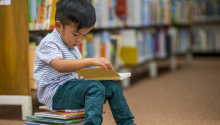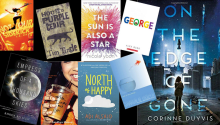The Annual Book Fair and Ice Cream Social!
Thank you very much to Ms. Toner, Lincoln School Librarian,
and All of the Parent Volunteers, and Fifth Grade Students
whose tremendous work and efforts helped make this
a wonderful evening for All!
and All of the Parent Volunteers, and Fifth Grade Students
whose tremendous work and efforts helped make this
a wonderful evening for All!
for fifth grade activities!
Chocolate or Vanilla?!
Families Join in the Fun!
Fifth Grade Demonstrate their Leadership Skills!
Griffin Miller, Principal For the Day, Took on many
responsibilities. He wrote reviews for 10 books in the Book Fair.
Many of the books he wrote about included diversity themes.
Gryffen also Created a Declaration for our Entire School! responsibilities. He wrote reviews for 10 books in the Book Fair.
Many of the books he wrote about included diversity themes.
On Friday, December 21, Gryffen has invited students and staff
to think about a family tradition or something special that you
might like to share with your class. This can be related to the
upcoming holiday season, or anything that you might like to share.
You can bring in an object, share a story, photograph,
or simply listen to others share.
Making Posters for the upcoming Movie Night
Featuring Santa Buddies! Wednesday, Dec. 12!
6:00 PM - 7:30 PM Lincoln School Auditorium
Several Teachers and I participated in
a professional development opportunity on
reading this week presented by Lucy Calkins.
| Ms. Blankenship, Gr. 5, Lucy Calkins, Ms. Coffil, Gr. 5 and Ms. Andella (Gr. 5 Muraco) |
(i.e. prediction, inference, characters act differently in different relationships, etc.)
Ms. Fitch, Gr. 3 listening as Lucy also stressed,
"Students should be reading at least 1 hour per day."
How can I learn more about
Mirrors and Windows?
Deepen your understanding of what mirrors and windows are and how they can best be implemented in your classroom. Here are some great books and blogs that can help:
- More Mirrors in the Classroom by Jane Fleming, Susan Catapano, Candace M. Thompson, and Sandy Ruvalcaba Carrillo
- Free Within Ourselves: The Development of African American Children’s Literature by Rudine Sims Bishop
- Teaching Tolerance
- White Teachers Need to See Color. Here’s Why.
What Are Mirrors and Windows?
Kids need stories that reflect their own experienceas well as the experiences of others. A good teacher works hard to develop relationships with students in order to help them identify their place in the world. A great way to help children do this effectively is to introduce stories and materials that act as mirrors and windows.You may have heard the term “mirrors and windows” being used more frequently lately, especially when it comes to literacy. But what does this phrase mean?
A good teacher works hard to develop relationships with students in order to help them identify their place in the world. A great way to help children do this effectively is to introduce stories and materials that act as mirrors and windows.You may have heard the term “mirrors and windows” being used more frequently lately, especially when it comes to literacy. But what does this phrase mean?What are mirrors and windows?
The phrase “mirrors and windows” was initially introduced by Emily Style for the National SEED Project. A mirror is a story that reflects your own culture and helps you build your identity. A window is a resource that offers you a view into someone else’s experience. It is critical to understand that students cannot truly learn about themselves unless they learn about others as well.Why are mirrors important?
Multicultural education scholar Rudine Sims Bishop talks about books as mirrors, which are texts in which children can find themselves, their families, and their communities reflected and valued. When students read books where they see characters like themselves who are valued in the world, they feel a sense of belonging. The first step is gathering diverse resources for your classroom. The second step is building a culturally sensitive curriculum that teaches all the things required of any standard-based curriculum. Putting up mirrors for your students merely means setting up the context for them, not doing it in addition to regular learning. So be sure that you hand pick the books your students will use to learn the standards. Here are some tools to help to make sure that happens:- How You Felt When You Recognized Yourself in a Book for the First Time
- What Is a Book Talk?: Your Guide to Making Them Work in the Classroom
- 32 Inspiring Books for Women’s History Month
- 20 #OwnVoices Books To Share With Middle and High School Kids
- 30 Children’s Books with LGBT Characters
- The 2018 Ultimate List of Diverse Children’s Books
- Kids Like Me: 18 Books with Diverse Main Characters
Why are windows important?
Bishop goes on to explain that windows help us develop understandings about the wider world. Students need to learn about how other people conduct themselves in the world in order to understand how they might fit in. This is where you’ll need to diversify your materials so that, regardless of who is in your classroom, all students get to see a window into the range of possibilities out in the world. For some children, this may be the first time they are exposed to differences in culture, skin color, religion, and lifestyle. It’s important that their introduction is one of non-judgment and supportive acceptance. Let kids find some comparisons on their own before guiding them to see similarities and differences. Share lots of picture books with all age groups so you can provide rich information about a lot of topics in a short period of time.
Don’t relegate mirrors and windows to literacy.
There are lots of ways to use the concept of mirrors and windows in other subjects. Problem solving lends itself nicely to getting kids to look at things from their own perspective as well as that of others. In his article Mirrors & Windows Into Student Noticing, Higinio Dominguez shares how this inward/outward process of thinking helps children reverse their poor self-concepts about certain subjects.Circle back around to give students
time to reflect.
Handing kids great books about characters they can relate to is important, but it loses its impact without reflection. Building identity is a long process which requires regular reflection and shifting of thoughts and ideas. Don’t expect kids to know how to do this work on their own. Besides asking open-ended questions that provoke metacognition (thinking about your thinking), try using a Howard Gardner strategy from Harvard’s Project Zero: When you want kids to reflect, have them write: I used to think _____, but now I think ____.With all new big concepts in education, this one will take consistency and practice. The reward, though, is a classroom of individual students who feel valued and are therefore more able to move forward into the world sharing their gifts. As teachers, we can’t hope to do more.



